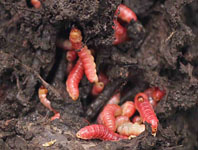Abstract
Cirolana bambang sp. nov. from Bitung, North Sulawesi, Indonesia is described. The species can be recognised by generally smooth body with small, acute, submedian nodules on pleonites 4–5 and the anterior dorsal surface of the pleotelson together with a flat, pentagonal frontal lamina, linguiform and sexually dimorphic pleotelson with the dorsal surface covered by short setae in males, deeply bifid uropod apices, and a conspicuously large robust seta on the superodistal angle of pereopod 1 ischium. Cirolana bambang sp. nov. appears to belong to a group of Indo-West Pacific Cirolana with prominent penial process, a large robust seta on the superodistal angle of pereopod 1 ischium and the presence of setae on dorsal surface of pleotelson and or uropod in males. The most similar species are Cirolana comata Keable, 2001; Cirolana dissimilis Keable, 2001; Cirolana aldabrensis Schotte & Kensley, 2005; and Cirolana somalia Schotte & Kensley, 2005. Cirolana kiliani Müller, 1993 and C. somalia are found not to belong to the Cirolana‘parva-group’.
References
Barnard, K.H. (1920) Contributions to the crustacean fauna of South Africa. 6. Further additions to the list of marine Isopoda. Annals of the South African Museum, 17, 319–438.
https://doi.org/10.5962/bhl.part.22318Bruce, N.L. (1986) Cirolanidae (Crustacea: Isopoda) of Australia. Records of the Australian Museum, 6 (Supplement), 1–239.
https://doi.org/10.3853/j.0812-7387.6.1986.98Bruce, N.L. (2004) New species of the Cirolana 'parva-group' (Crustacea: Isopoda: Cirolanidae) from coastal habitats around New Zealand. Species Diversity, 9, 47–66.
Bruce, N.L. & Brandt, A. (2006) A new species of Cirolana Leach, 1818 (Crustacea, Isopoda, Cirolanidae) from the western Ross Sea, Antarctica, the first record of the genus from polar waters. Zoosystema, 28, 315–324.
Bruce, N.L. & Wong, H.P.S. (2015) An overview of the marine Isopoda (Crustacea) of Singapore. Raffles Bulletin of Zoology. Supplement, 31, 152–168.
Bruce, N.L. & Schotte, M. (2015) Cirolana Leach, 1818. In: Boyko, C.B., Bruce, N.L., Hadfield, K.A., Merrin, K.L., Ota, Y., Poore, G.C.B., Taiti, S., Schotte, M. & Wilson, G.D.F. (Eds.), (2008 onwards). World Marine, Freshwater and Terrestrial Isopod Crustaceans database. Available from: http://marinespecies.org/isopoda/aphia.php?p=taxdetails&id=118399 (accessed 26 July 2017)
Brusca, R.C., Wetzer, R. & France, S.C. (1995) Cirolanidae (Crustacea: Isopoda: Flabellifera) of the tropical eastern Pacific. Proceedings of the San Diego Society of Natural History, 30, 1–96.
Dana, J.D. (1852) On the classification of the Crustacea Choristopoda or Tetradecapoda. American Journal of Sciences and Arts, 2, 297–316.
Hobbins, C. St. C. & Jones, D.A. (1993) New species of deep sea isopods from the Red Sea and North West Indian Ocean: Families Cirolanidae and Corallanidae. Senckenbergiana Maritima, 23, 115–234.
Keable, S.J. (1995) Structure of the marine invertebrate scavenging guild of a tropical reef ecosystem: field studies at Lizard Island, Queensland, Australia. Journal of Natural History, 29, 27–45.
https://doi.org/10.1080/00222939500770021Keable, S.J. (2001) Three new species of Cirolana Leach, 1818 (Crustacea: Isopoda: Cirolanidae) from Australia. Memoirs of Museum Victoria, 58, 347–364.
https://doi.org/10.24199/j.mmv.2001.58.18Leach, W.E. (1818) Cymothoadées. In: Cuvier, F. (Ed.), Dictionnaire des Sciences Naturelles. Strasbourg et Levrault, Paris, pp. 338–354.
Lowry, J.K. & Smith, S.D.A. (2003) Invertebrate scavenging guilds along the continental shelf and slope of eastern Australia – general description. The Australian Museum, Sydney, 59 pp.
Manning, R.B. (1986) A small trap for collecting crustaceans in shallow water. Proceedings of the Biological Society of Washington, 99, 266–268.
Müller, H.-G. (1993) Cirolanidae of the genera Calyptolana, Cirolana, Neocircolana, Colopisthus and Excirolana from the Santa Marta area, Caribbean Sea of Colombia (Crustacea: Isopoda: Cymothoida). Zoologischer Anzeiger, 230, 191–225.
Rodcharoen, E., Bruce, N.L. & Pholpunthin, P. (2014) Cirolana songkhla, a new species of brackish-water cirolanid isopod (Crustacea, Isopoda, Cirolanidae) from the lower gulf of Thailand. Zookeys, 375, 1–14.
https://doi.org/10.3897/zookeys.375.6573Rodcharoen, E., Bruce, N.L. & Pholpunthin, P. (2016) Description of four new species of the Cirolana ‘parva group’ (Crustacea: Isopoda: Cirolanidae) from Thailand, with supporting molecular (COI) data. Journal of Natural History, 50 (31–32), 1935–1981.
https://doi.org/10.1080/00222933.2016.1180718Rodcharoen, E., Bruce, N.L. & Pholpunthin, P. (2017) Cirolana phuketensis, a new species of marine isopod (Crustacea: Isopoda: Cirolanidae) from the Andaman Sea coast of Thailand. ZooKeys, 695, 1–17.
https://doi.org/10.3897/zookeys.695.13771Schotte, M. & Kensley, B. (2005) New species and records of flabelliferan isopod crustaceans from the Indian Ocean. Journal of Natural History, 39, 1211–1282.
https://doi.org/10.1080/00222930400005757Sidabalok, C.M. (2013) List of marine isopods recorded from Indonesian waters. Marine Research in Indonesia, 38, 49–66.
https://doi.org/10.14203/mri.v38i1.56Sidabalok, C.M. & Bruce, N.L. (2015) Revision of the cirolanid isopod genus Odysseylana Malyutina, 1995 (Crustacea) with description of two new species from Singapore. Zootaxa, 4021 (2), 351–367.
https://doi.org/10.11646/zootaxa.4021.2.6Sidabalok, C.M. & Bruce, N.L. (2016) Redescription of three cirolanid isopods (Crustacea: Peracarida) from Indonesia. Zootaxa, 4114 (3), 277–290.
https://doi.org/10.11646/zootaxa.4114.3.4Sidabalok, C.M. & Bruce, N.L. (2017) Review of the species of the Cirolana ‘parva-group’ (Cirolanidae: Isopoda: Crustacea) in Indonesian and Singaporean waters. Zootaxa, 4317 (3), 401–435.
https://doi.org/10.11646/zootaxa.4317.3.1Sidabalok, C. & Bruce, N.L. (2018) Review of the Cirolana ‘pleonastica-group’ (Crustacea: Isopoda: Cirolanidae) with description of four new species from the Indo-Malaysian region. Raffles Bulletin of Zoology. [submitted]
Wägele, J.-W. (1989) Evolution und phylogenetisches System der Isopoda. Stand der Forschung und neue Erkenntnisse. Zoologica, 140, 1–262.

